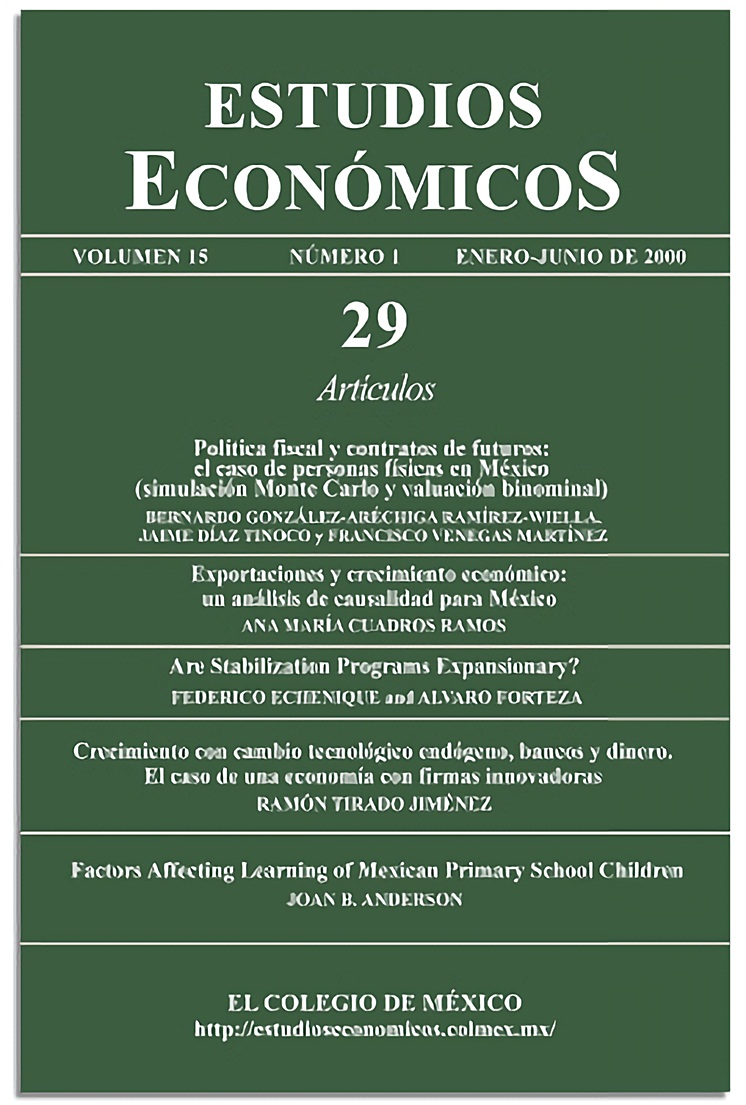Crecimiento con cambio tecnológico endógeno, bancos y dinero. El caso de una economía con firmas innovadoras
Publicado 2000-01-01
Palabras clave
- actividad bancaria,
- tasa de crecimiento,
- cambio tecnológico endógeno
Cómo citar
Resumen
El objetivo del presente artículo es exponer y analizar un modelo de crecimiento con cambio tecnológico endógeno, en el contexto de una economía compuesta por bancos y dinero. En la teoría del crecimiento económico no existen, de hecho, análisis que sigan las líneas anteriores. Aquí se presentan algunos resultados centrales que relacionan la no superneutralidad del dinero con la actividad bancaria y sus efectos sobre la tasa de crecimiento que una economía innovadora puede alcanzar. Se muestran además los casos de un banco neutral al riesgo y otro adverso al riesgo, con los que se puede concluir que las conductas bancarias juegan un papel decisivo en la determinación de la tasa de crecimiento de equilibrio, en tanto agente que administra el ahorro realizado por los individuos. Por otra parte, se describe que la política monetaria afecta el desempeño de largo plazo de una economía a través del sector bancario.
Descargas
Citas
- Aghion, Phillipe y Peter Howitt (1998). Endogenous Growth Theory, MIT Press.
- Aghion, Phillipe y Peter Howitt (1992). “A Model of Growth Through Creative Destruction”, Econometrica.
- Arrow, Keneth J. (1962a). “El bienestar económico y la asignación de recursos para la invención”, en N. Rosenberg (Comp.), Economía del cambio tecnológico, FCE, El Trimestre Económico, Lecturas 31, México, pp. 151-167.
- Arrow, Keneth J. (1962b). “The Economic Implications of Learning by Doing”, Review of Economic Studies, 29, pp. 155-173.
- Barro, Robert y Xavier Sala-i-Martin (1995). Economic Growth, McGraw-Hill.
- Bencivenga, Valerie y Bruce D. Smith (1991). “Financial Intermediation and Endogenous Growth”, Review of Economic Studies, 58, pp. 195-509.
- Benetti, Carlo (1990). Moneda y teoría del valor, UAM-FCE, México.
- Bernanke, Ben y Alan Blinder (1988). “Credit, Money and Aggregate Demand”, en G. Mankiw y D. Romer, New Keynesian Economics, vol. 2, MIT Press, pp. 325-336.
- Blanchard, Oliver (1990). “Why Does Money Affects Output?”, en B. M. Friedman y F. H. Hahn (Comps.), Handbook of Monetary Economics, vol. II, North Holland.
- Blanchard, Oliver y Stanley Fisher (1989). Lectures on Macroeconomics, MIT Press.
- Blinder, Alan (1997). Central Banking in Theory and Practice, MIT Press.
- Brock, W. A. (1974). “Money and Growth: The Case of Long Run Perfect Foresight”, International Economic Review, 15.
- Geweke, J. (1986). “The Superneutrality of Money in the United States: An Interpretation of the Evidence”, Econometrica, 54, pp. 1-21.
- Greenwood, Jeremy y Bruce D. Smith (1997). “Financial Markets in Development and the Development of Financial Markets”, Journal of Economic Dynamics and Control, 21, pp. 145-181.
- Grossman, Gene y Elhanan Helpman (1991). Innovation and Growth in the Global Economy, MIT Press.
- Gomme, P. (1993). “Money and Growth Revisited: Measuring the Costs of Inflation in an Endogenous Growth Model”, Journal of Monetary Economics, 32.
- Ireland, P. (1994). “Money and Growth: An Alternative Approach”, The American Economic Review, Marzo.
- Jun, S. (1988). “The Long-Run Neutrality of Money: In Levels and in Growth Rates”, (mimeo).
- King, Robert y Ross Levine (1993). “Finance, Entrepeneurship and Growth. Theory and Evidence”, Journal of Monetary Economics, 32, pp. 513-542.
- LeRoy Miller, Roger y Robert W. Pulsinelli (1992). Moneda y banca, McGraw-Hill, 2a. ed.
- Lucas, Robert E. Jr. (1988). “On the Mechanics of Economic Development”, Journal of Monetary Economics, 22, pp. 3-42.
- Lucas, Robert E. Jr. (1993). “Making a Miracle”, Econometrica, 61, pp. 251-272.
- Mankiw, N. Gregory (1986). “The Allocation of Credit and Financial Collapse”, en G. N. Mankiw and D. Romwe (Comps.), New Keynesian Macroeconomics.
- Merton, Robert K. (1990). “Pricing Non-Monetary Assets”, en B. M. Friedman y F. H- Hahn. Handbook of Monetary Economics, vol. 1, North Holland.
- Mino, K. y A. Shibata (1995). “Monetary Policy, Overlapping Generations, and Patterns of Growth”, Economica, 62, pp. 179-194.
- Orphanides, Athanasios y Robert Solow (1990). “Money, Inflation and Growth”, en B. M. Friedman y F. H. Hahn, Handbook of Monetary Economics, vol. 1, North Holland, pp. 224-260.
- Romer, David (1996). Advanced Macroeconomics, McGraw-Hill.
- Romer, Paul M. (1994). “The Origins of Endogenous Growth”, Journal of Economic Literature, 8.
- Romer, Paul M. (1990). “Endogenous Technological Change”, Journal of Political Economy, 98, pp. 71-102.
- Romer, Paul M. (1986). “Increasing Returns and Long-Run Growth”, Journal of Political Economy, 94, pp. 1002-1037.
- Shi, Shouyong (1996). “Asymmetric Information, Credit Rationing and Economic Growth”, Canadian Journal of Economics, vol. 29, pp. 665-687.
- Sidrauski, Miguel (1967). “Inflation and Economic Growth”, Journal of Political Economy, vol. 75, pp. 796-810.
- Stein, J. L. (1970). “Monetary Growth Theory in Perspective”, American Economic Review, vol. 60, pp. 85-106.
- Stiglitz, Joseph y Andrew Weiss (1981). “Credit Rationing in Markets with Imperfect Information”, en G. N. Mankiw y D. Romer (Comps.), New Keynesian Economics, MIT Press, vol. 2, pp. 247-276.
- Stiglitz, Joseph y Andrew Weiss (1965). “Money and Economic Growth”, Econometrica, vol. 33, pp. 671-684.
- Stiglitz, Joseph y Andrew Weiss (1961). “Money, Capital and other Stores of Value”, American Economic Review, Papers and Proceedings, vol. 51, pp. 26-37.
- Stiglitz, Joseph y Andrew Weiss (1958). “La preferencia por la liquidez como comportamiento frente al riesgo”, en E. Mueller, Lecturas de Macroeconomía, CECSA, México, pp. 181-200.
- Tobin, James (1955). “A Dynamic Aggregative Model”, Journal of Political Economy, vol. 63, pp. 103-115.

